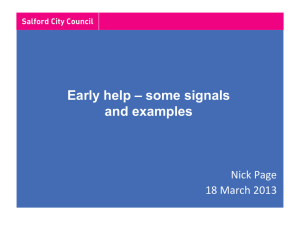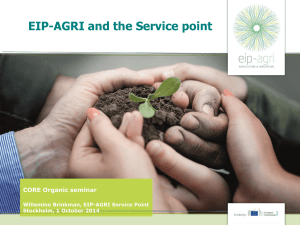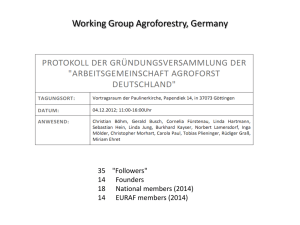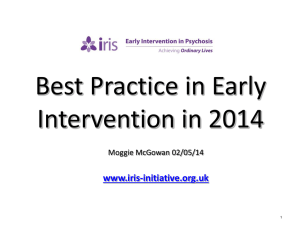Alison Brabban, National Advisor for Severe Mental illness, IAPT
advertisement
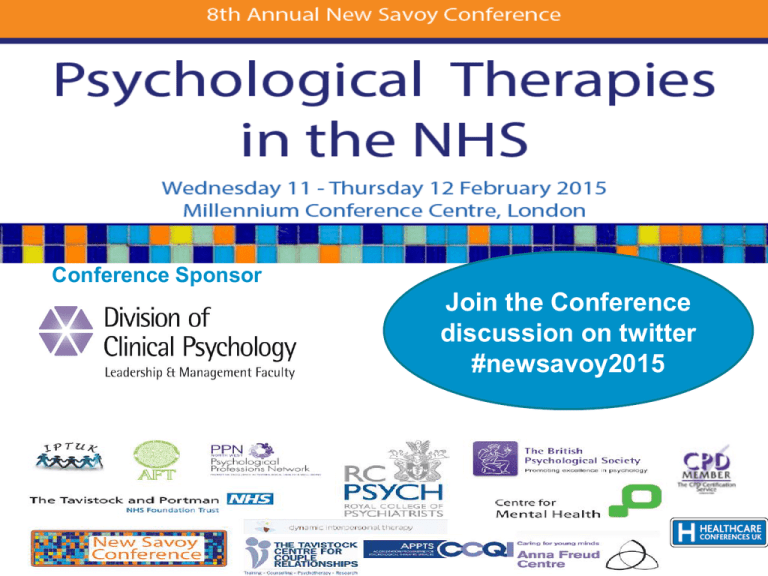
Conference Sponsor Join the Conference discussion on twitter #newsavoy2015 Improving Access To Psychological Therapies for People in Early Intervention in Psychosis Services Alison Brabban Sarah Khan What Service Users Want • To be listened to. • To have experiences and feelings validated. • To be seen as a person and not just as a set of symptoms. • To get help to make sense of their experiences. • To be given hope. 3 NICE Guidelines for Schizophrenia & Psychosis Update (2009) We now have good evidence that CBT and FI for psychosis works. CBT evidence: 31 RCTs reviewed, quality checks on methodology (N=3052). (22 new trials) Small but clear effect size on symptoms, including depression, but not on relapse rates. FI for psychosis evidence: 38 RCTs met quality checks (5 were follow ups) (N=3134). 32 studies (19 new trials) (N=2429) included in meta analysis. FI reduce relapse consistently. “These are substantial gains, considering the fact that the effects of such psychological treatments add to medication.” Pfammatter et al (2011) p.S1. (Schizophrenia Bulletin, 37 suppl 2, S1-S4) 4 Who Should be Offered CBTp and Family Interventions? NICE (2014) • Those “at-risk” of developing psychosis (should not be offered antipsychotic medication). • Those with a first episode of psychosis (if person wants to try therapy alone, go ahead, but advise that more effective if combined with medication – review after a month). • Anyone with a diagnosis of schizophrenia or psychosis irrespective of phase (i.e. acute, in remission). 5 How it should therapies be delivered? CBTp: • On a one to one basis (rather than group based). • Offer at least 16 sessions. Family Interventions: • As single or multi family group (and include service user) • 3 months to 1 year. • At least 10 planned sessions For Both… • Therapists should have appropriate competence (see competence framework). • Therapists should have regular clinical supervision from competent supervisors. • Outcomes should be monitored regularly. Availability of CBTp and FI • According to National Audit of Schizophrenia: • 39% of people have been offered CBT • 12% of people said they had received a family intervention. • But…. • What type of CBT (was it CBTp?) • What kind of family intervention? • How competent were the therapists? Availability of CBTp & FI (from Specialist Psychological Therapy Audits) • Approx 10% of service users had access to CBTp • Less than 3% of Families were offered Family Interventions Barriers to Implementation • Lack of staff with appropriate competences • Lack of available training • Lack of available clinical supervision • Lack of ring-fenced time (specific therapy posts) – competing demands. • Priorities and team culture Early Intervention in Psychosis Services The Ethos of EIP • Target those with a first episode of psychosis (and those with ultra high risk of developing psychosis) • Aim to reduce Duration of Untreated Psychosis to less than 3 months. • Provide the full range of evidence based psychological & social interventions plus medication. • Involve families/carers whenever possible. • Recovery orientated: aim to improve wellbeing, purpose & meaning to life not merely symptom reduction. • Attempt to reduce stigma associated with psychosis and increase therapeutic optimism. The Success of EIP • Improve outcomes: Reduce hospitalisation, improve engagement, reduce suicide rates, increase employment, reduce likelihood of being detained under MHA. • Save Money (estimated net savings of £7972 per person after 3 years mainly to NHS. Over a ten-year period, £15 in costs can be avoided for every £1 invested. (Knapp et al (2014)). • Are evidence based and therefore recommended by NICE. • High level of satisfaction from Service Users and Carers (see ‘Schizophrenia Commission’ report) * Why does EIP work? • Capped case loads? • Recovery focused? • Skilled & passionate staff? • Team culture is psychosocially orientated? • Access to full range of evidence based interventions including psychological therapies? Features of EIP delivery allow implementation of psychological therapies • 50% of EIP services reported that their budgets had been cut in the last year. • 53% of EIP services reported that the quality of their services had reduced in the last year • 58% of EIP services have lost staff over the last 12 months. The New Access Standard Why introduce access and waiting time standards for mental health services? 16 NHS | Presentation to [XXXX Company] | [Type Date] MH 5YP: rebalancing the system An effective ‘in balance’ mental health system would: • Ensure rapid detection of mental ill health and access to evidence- based treatment in community settings. • Provide responsive and compassionate care to individuals at risk of or in crisis. • Provide safe, high quality inpatient care where community alternatives are not appropriate • Enable discharge from inpatient care through provision of personalised packages of home-based support www.england.nhs.uk The system is currently not in balance www.england.nhs.uk There is a 15-20 year gap in the life expectancy of individuals with serious mental illness compared with the rest of the population Health promotion activity, physical health assessments and interventions need to be integrated at every level if the 15-20 year mortality gap is to be closed. www.england.nhs.uk We are also missing opportunities to deliver better value care to individuals receiving treatment for a physical health condition If we are to improve outcomes and quality of life for individuals with physical health needs, then: a. Promotion of positive mental health as part of condition management b. Recognition of mental health needs c. Timely access to expert assessment and evidence based mental health care Will need to be integrated at every level of the physical healthcare system. a+b+c = reduced demand from repeat attendances in primary care, UEC and outpatient clinics = reduced acute length of stay = better outcomes at lower cost for individuals with long term conditions www.england.nhs.uk The 15/16 Access & Waiting Time Standards By April 2016: • 75% of people referred to the Improved Access to Psychological Therapies programme will be treated within 6 weeks of referral, and 95% will be treated within 18 weeks of referral. • More than 50% of people experiencing a first episode of psychosis will be treated with a NICE approved care package within two weeks of referral. And there will be: • 21 £30m targeted investment on effective models of liaison psychiatry in a greater number of acute hospitals. Availability of liaison psychiatry will inform CQC inspection and therefore contribute to ratings. The Financial Package Using a new £40 million funding boost for mental health services, secured to kick-start delivery of the 2020 vision, we will be building capacity in some priority areas in order to prepare for the introduction of new access standards in the following year. £7m to CAMHS T4, £33m to EIP and crisis care in 14/15 Plus: 4 x 200k EIP regional preparedness money In 2015/16 a further £80m will be freed from existing budgets, enabling introduction of the first access and waiting times standards of their kind – lines in the sand – to be set on parity of esteem for mental health services. £40m to be targeted recurrently on EIP, £30m on liaison psychiatry and £10m on IAPT 22 Approach to supporting implementation of the new standards 23 NHS | Presentation to [XXXX Company] | [Type Date] National resources to support implementation 1. Bringing together the required expertise National expert reference group, NCCMH ‘hosting’, highly collaborative. Regional implementation steering groups. 2. Developing the required dataset – waiting times, quality of care, outcomes Different approaches for 15/16 and 16/17 and beyond. Potential use of national clinical audit and accreditation scheme. Laying the groundwork for other A&W standards 3. Publication of commissioning guidance Service specifications, service model exemplars, staffing / skill mix calculators etc 4. Design of levers & incentives Planning guidance, payment system development, standard contract etc. Engagement with Monitor, TDA, CQC. 5. Implementation support Sponsoring development of learning networks, regional and national events etc. 6. Workforce development Joint work with HEE 24 25 Draft EIP Referral to Treatment (RTT) pathway Referrer Referrer suspects suspects first first episode episode psychosis psychosis (FEP) (FEP) Urgent Urgent // emergency emergency referral referral made made flagged flagged as as suspected suspected FEP FEP Central Central triage triage point? point? Y Clock Clock starts starts when when central central triage triage point point receives receives referral referral Onward Onward referral referral to to EIP EIP service service N Clock Clock starts starts when when EIP EIP service service receives receives referral referral Patient Patient invited invited for for EIP EIP assessment assessment N DNA? DNA? EIP EIP assessment assessment commences commences Y Active Active monitoring monitoring // watch watch and and wait wait DNA DNA Y Active Active monitoring monitoring // watch watch and and wait wait N EIP EIP assessment assessment completed completed FEP? FEP? N Y Clock Clock stops stops when: when: 1. 1. Accepted Accepted on on to to EIP EIP caseload caseload 2. EIP care 2. EIP care coordinator coordinator allocated allocated 3. 3. NICE NICE concordant concordant package package of of care care commenced. commenced. Clock Clock stops stops when: when: 1. 1. Accepted Accepted on on to to EIP caseload EIP caseload 2. 2. EIP EIP care care coordinator coordinator allocated allocated 3. 3. Specialist Specialist ARMS ARMS assessment assessment commenced. commenced. ARMS? ARMS? Y N Onward Onward referral referral to to appropriate appropriate service service or or discharge discharge 26 Commence Commence NICE NICE concordant concordant package package of of care care Referral to clock start 1. 1. Referrer Referrer suspects suspects first first episode episode psychosis psychosis (FEP) (FEP) 2. 2. Urgent Urgent // emergency emergency referral referral made made flagged flagged as as suspected suspected FEP FEP Central Central triage triage point? point? Y 3a. 3a. Clock Clock starts starts when when central central triage triage point point receives receives referral referral Onward Onward referral referral to to EIP EIP service service N 3b. 3b. Clock Clock starts starts when when EIP service EIP service receives receives referral referral 27 Patient Patient invited invited for for EIP EIP assessment assessment Assessment 1. Patient 1. Patient invited EIP for EIP invited for assessment assessment 2a. 2a. N DNA or DNA or cancella cancella tion? tion? EIP EIP assessment assessment commences commences Y Y 3a. Active 3a. Active monitoring monitoring // watch and watch and wait wait 28 2b. 2b. DNA or DNA or cancell cancell ation? ation? 3b. Active 3b. Active monitoring monitoring // watch and watch and wait wait N EIP EIP assessment assessment completed completed Assessment to clock stop 1. 1. EIP EIP assessment assessment completed completed FEP? FEP? N Y 2a. 2a. Clock Clock stops stops when: when: 1. 1. Accepted Accepted on on to to EIP EIP caseload caseload 2. 2. EIP EIP care care coordinator coordinator allocated allocated 3. 3. NICE NICE concordant concordant package package of of care care commenced. commenced. 2b. 2b. Clock Clock stops stops when: when: 1. 1. Accepted Accepted on on to to EIP EIP caseload caseload 2. 2. EIP EIP care care coordinator coordinator allocated allocated 3. 3. Specialist Specialist ARMS ARMS assessment assessment commenced. commenced. 3. 3. ARMS? ARMS? Y N Onward Onward referral referral to to appropriate appropriate service service or or discharge discharge 29 Commence Commence NICE NICE concordant concordant package package of of care care EIP – Regional Leads London South Midlands & East North Stefanie Radford stefanie.radford@ nhs.net Belinda Lennox belinda.lennox@p sych.ox.ac.uk Peter Jones pbj21@cam.ac.uk Alison Brabban abrabban@btopen world.com David Monk david.monk@sym metricpartnership. co.uk Sarah Amani sarah.amani@earl yintervention.oxfor dahsn.org Finola Munir finola.munir@nhs. net Colin McIlwain colin.mcilwain@nh s.net 30 NHS | Presentation to [XXXX Company] | [Type Date] Regional preparedness work 1. Raising awareness – What are the requirements of the new standard? What are the implications? What are the opportunities? 2. Bringing together the experts and establishing quality improvement networks 3. Understanding demand – incidence, incidence profiles etc 4. Understanding the baseline position + gap analysis – staffing, skill-mix, competency to deliver full range of NICE concordant interventions (the 2 week wait is the easy part…) 5. Optimising RTT pathways – need to engage all of the potential referral sources, many of which will be internal within secondary care 6. Preparing for the new data collection requirements – training for service and information leads 7. Developing the workforce – capacity, skills & leadership – can the workforce deliver the full range of NICE concordant interventions as this will be the definition of ‘treatment’? 31 Challenges • We need to prepare this implementation support package quickly but we also want to do it well • Needs to be shared understanding regarding not only on the benefits of EIP services but also ‘what good looks like’ and the complete package of interventions / staffing / skillmix required to deliver these benefits. • Investing ‘upstream’ always more challenging against a background of significant financial pressures • Delivery of the EIP standard will require significant workforce development – capacity and access to accredited training programmes • A paucity of granular baseline data 32 Opportunities • We have a real opportunity to improve the quality of care that people receive and improve outcomes • Can set a precedent for future access & waiting time standards – clinically informed waiting time standards for evidence based care • Doing this quickly and doing this well will demand collaboration and joint working – great energy and enthusiasm to be harnessed • Opportunities to review levers and incentives to try to ensure that they better ‘line up’ to incentivise timely access to effective care • Could deliver a ‘step change’ in the quality of the data that we have available to evaluate the value of care delivered 33 What Next? • Additional ring fenced therapy posts (How Many?) (New recurrent funding announced by NHSE) • Additional Staff with competences to deliver psychological therapies • National syllabus • Accredited Training Available (inc supervision) • Funding required to deliver this (HEE and MH provider commitment required). • Demonstrate impact: collect relevant intervention and outcomes data. alison.brabban@nhs.net sarah.khan@nhs.net 35 ] Conference Sponsor Join the Conference discussion on twitter #newsavoy2015
